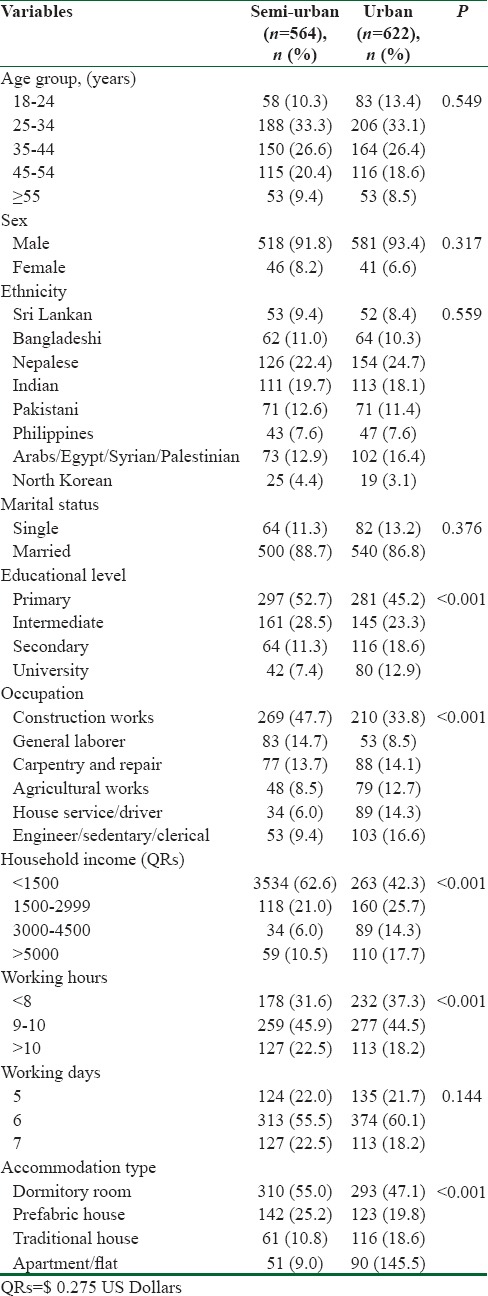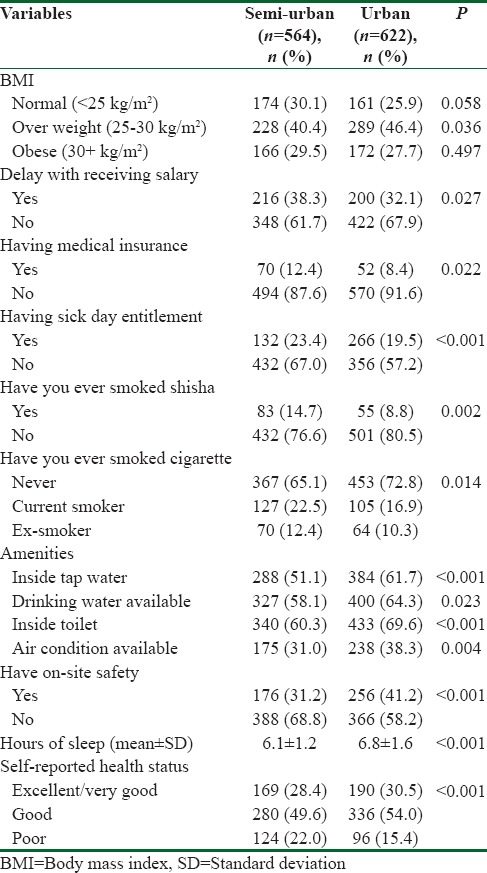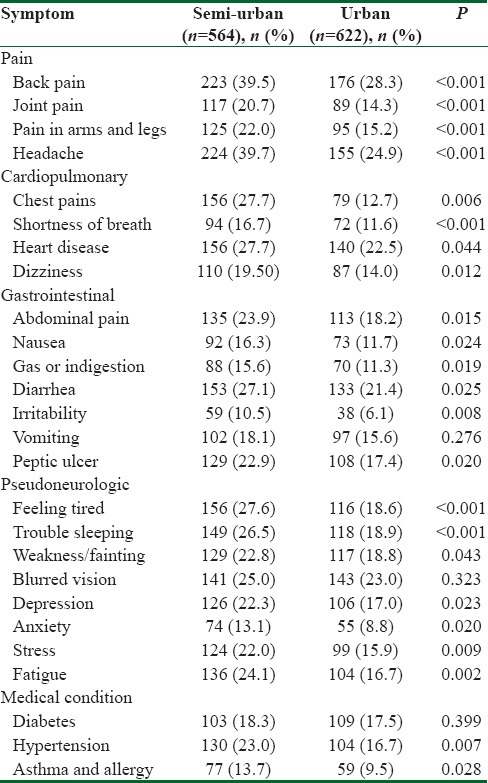Abstract
Background:
Very little research and survey have been performed on the occupational health, hazards, and working condition of urban and rural of workers in Qatar. The aim of the current study is to identify the health status, lifestyle condition, working-related problems, and accidents experienced by Indian subcontinental migrants (ISCM) in Qatar and their access to health-care facilities.
Methods:
This is a cross-sectional study based on a representative sample of 1186 workers and study covering sociodemographic characteristics, medical conditions, and health-seeking behaviors and personal experience.
Results:
There were statistically significant differences between semi-urban and urban migrant workers in terms of educational, occupation, income, working hours, and accommodation type (P < 0.001). Furthermore, there were statistically significant differences between migrant workers in terms of body mass index, delay in receiving salary, the right to medical insurance and sick day entitlement, cigarettes and shisha smoking, amenities, having on-site safety measure, and sleeping hours (P < 0.01). Moreover, there were statistically significant differences between semi-urban and urban migrant workers in terms of pain, cardiopulmonary, gastrointestinal, and pseudoneurologic and medical symptoms (P < 0.01). Multiple logistic regression was used for predictors’ health problems in migrant workers such as the absence of drinking water, tap water availability, safety facility tools, occupational status, shisha smoking, toilet facility, working hours, and accommodation type were considered the strong predictors.
Conclusions:
The current study revealed that there is a lack of insufficient information for the migrants about their lifestyle, medical conditions, health risks, injury, and rights privilege in relation to legal working condition and health services.
Keywords: Access health care, health status, lifestyle, migrant workers, safety
Introduction
Although the State of Qatar is a relatively new nation in the Middle East, Qatar has rapid developments, especially in the petroleum, airline, maritime, commercial, and construction industries.[1,2] The economic and industrial developments have caused numerous social and environmental problems during the past two decades.[1] Exposure to lead is considered a primary health issue in the industrial and oil-producing countries. In Qatar, the increase in the amount of oil and gas has been associated with the growth of urbanization and industry and increasing number of motor vehicles in transport.[2]
Low-skilled or unskilled workers are employed from poor countries with usually short-term contracts by most of the oil-rich countries.[1,2,3,4,5] They are recruited usually in projects which need workforce such as construction and service industries.[1,2] Majority of the workers usually do not have enough access to health-care facilities. The main reasons can be language and cultural differences to access health care.[6,7,8] Overall, South Asian countries and North Africa are the main suppliers of migrant workers to the State of Qatar and other Gulf countries.[2,9,10,11,12,13,14]
More recently, it was asked by Guardian Newspaper that “Have Qatar's work conditions could be improved?”[15] Numerous workers still complain about low payment, long work hours, and limitation of migrant workers’ rights and freedoms despite better accommodation and new payment rules.[15,16] Migrant workers’ salary and payment conditions are not good, for example, the salaries of carpenters and steel fixers working on a World Cup stadium[17] site ranging from $250 to $300 US dollars with overtime. Qatari government commissioned detailed report[18] for improving life conditions for migrant laborers with suggested substantial reforms.
During 2014, over 80% of all migrant workers in Qatar were expatriated. More than 1.5 million migrant workers were from South Asian countries such as India, Nepal, Pakistan, Bangladesh, Sri Lanka, Pilipino, and Korea.[19,20] It is estimated that one million migrant workers will be recruited in many projects including construction, soccer stadiums, urban–rural roads, tunnel, and metro railway systems for the preparation of World Cup football matches in 2022.
The aim of the current study is to identify the health status, lifestyle condition, work problems, and accidents experienced by Indian subcontinental migrants (ISCM) migrant workers in Qatar and their access to health-care facilities in urban and semi-urban areas.
Methods
This is a cross-sectional study of the self-reported health condition of the migrant workers during their stay in Qatar. As of December 2013, there were an estimated 1,466,851 migrant workers in Nepalese, Indian, Bangladeshi, Sri Lankan, Arabs, and Pakistani workforce (ISCM) in Qatar. Of these, 1,466,851 were semi-skilled or unskilled workers including over 1.2 million in construction.[19,20]
The data were collected in January 2013 to June 2014 from various types of location: the International Airport, shopping malls, bus parking area, and working sites. The inclusion criteria of the present study were being adult people who had work experience of at least 12 months in Qatar; meanwhile, in most cases, working contract is about minimum 18 months. We have developed and partially used the previous questionnaire on the basis of author experience in this area which is one of the demographic and clinical questionnaires were adopted from a previous study.[12] We computed the sample size based on 50% prevalence of migrants might have access to health-care services, assuming 3.2% bound on error estimation, and taking 99% confidence level, the required minimum sample size for this study was n = 1623.

We have obtained a list of representative sample of 1623 workers, and we have approached workers, but 1186 participants agreed to participate in this study (73%). Urban area is mostly thickly populated area, usually greater than a town and larger congested area, having fixed boundaries and certain local powers of government. Semi-urban population is not thickly populated area with homogeneous people, and it is quite place and has less economic development.
The variables in the analysis were the migrants’ self-reported health problems and the accidents during their past 12 months of working period in Qatar. The self-reported questions were did you suffer from any health problem during your past 12 months of stay in that region? Did you have any type of injury or accident at your workplace during past 12 months? Variables such as age, marital status, occupation, educational status, ethnicity, working hours, accommodation type, body mass index (BMI), and types of health problems were recorded.
The data were analyzed using the Statistical Package for the Social Sciences (IBM SPSS Statistics for Windows, Version 22.0. Armonk, NY: IBM Corp). Student's t-test was used to ascertain the significance of differences between mean values of two continuous variables. Chi-square and Fisher's exact test (two-tailed) were used to test for differences in proportions of categorical variables between two or more groups. Multiple logistic regression analysis method was used to assess the potential confounders and order the importance of risk factors for the health problems. P < 0.05 was considered as the cutoff value for significance.
Results
Table 1 shows comparison of sociodemographic characteristics among participants from semi-urban and urban locations. There were statistically significant differences between semi-urban and urban migrant workers in terms of educational level, occupation status, household income, working hours, and accommodation type (P < 0.001).
Table 1.
Sociodemographic characteristics of the studied participants (n=1186)

Table 2 shows some important comparison of working and lifestyle characteristics of migrant workers among participants from semi-urban and urban locations. There were statistically significant differences between semi-urban and urban migrant workers in terms of BMI, delay with receiving salary, having medical insurance, having sick day entitlement, smoking cigarettes and shisha smoking, amenities, having on-site safety measure, number of hours sleeping, and self-reported health status (P < 0.01).
Table 2.
Some important characteristics lifestyle habits among the studied participants (n=1186)

Table 3 shows some important comparison of lifetime prevalence of medical symptoms among migrant workers from semi-urban and urban locations. There were statistically significant differences between semi-urban and urban migrant workers in terms of pain, cardiopulmonary, gastrointestinal (GI), and pseudoneurologic and medical symptom conditions grouping (P < 0.01).
Table 3.
Prevalence of medical conditions among studied participants (n=1186)

Figure 1 shows the type of occupational accidents according to locations. As can be seen from this figure that there were statistically significant differences between semi-urban and urban migrant workers in terms of over half of the fatal injuries to workers were of three kinds of most common falls from height (18.6%), then slip/trip (8.5%), followed by machinery accidents (7.3%) (P = 0.014).
Figure 1.

Type of common occupational accidents
Multiple logistic regression method was used to investigate the potential confounding risk factors in the multivariable analyses. Table 4 identified the predictors for health problems in migrant workers such as absence of drinking water (odds ratio [OR] = 2.73; 95% confidence interval [CI]: 2.48–3.95, P < 0.001), inside tap water availability (OR = 2.69; 95% CI: 2.24–3.58, P = 0.003), safety facility and tools (OR = 2.73; 95% CI: 2.48–3.95, P < 0.001), occupational status (OR = 2.13; 95% CI: 1.65–3.22, P < 0.001), shisha smoking (OR = 1.96; 95% CI: 1.27–3.14. P = 0.031), toilet facility, (OR = 1.94; 95% CI: 1.36–3.02, P = 0.044), working hours (OR = 1.82; 95% CI: 1.53–2.16, P = 0.034), and accommodation type (OR = 1.66; 95% CI: 1.38–2.49, P = 0.008) were considered the strong predictors and significant contributing risk factors for health problems after adjusting for age, gender, and other variables.
Table 4.
Multivariable logistic regression analysis predictors for determinants of health problem (n=1186)

Discussion
In Arabian Gulf countries, Qatar is a top country which is recruited a great number of migrant workers. As of December 2013, it was estimated that 1,466,851 migrants were working in Qatar and over 1.2 million were semi-skilled or unskilled workers including construction.[19,20] Those increasing number of migrant workers and long working hours will lead an increase in the risk of occupational health conditions, occupational, and traffic accidents.[15,17,19] Migrant workers are also at risk from occupational medical condition and health problems such as pain, cardiopulmonary heart and respiratory diseases, GI abdominal, diarrhea, vomiting and peptic ulcer, pseudoneurologic-like fatigue, depression, anxiety and stress, and medical condition, i.e., diabetes, hypertension, and asthma and allergic diseases. Furthermore, it is reported that busy schedule and unsanitary lifestyle cause outbreaks of infectious diseases such as tuberculosis and pneumonia.[21] The suitable and timely access to health-care facilities may help to eliminate the high risk of health problems, particularly among low-income workers. The results of the current study are consistent with the Singapore study[22] and other neighboring Gulf Arab Countries’ study.[23]
The risk of occupation and poor knowledge about health and safety rules lead to occupational-related health problems in Qatar. The present study found that there are many differences in terms of socioculture, religion, and education between the ethnic groups.[23] A greater part of the Qatari's workforce is at risk during the summer months where mostly working 10–12 h with over 45°C. About over 12,000 cases of heat-related illness were treated in health centers at the Hamad Medical Corporation, accident emergency departments (AED) during 2013.[24,25]
In fact, immigration and health care are controversial concerns politically, socially, economically, and ethically. Immigration has determined as a deep subject with more than 2 million migrant labors who are working and living in Qatar now. Over 80% of these labors have arrived from ISCM (Nepalese, Indian, Bangladeshi, Sri Lankan, and Pakistani) and Arab countries.[19,20,24,25] Many of those immigrants are not able to totally use the health-care facilities. They do not access to emergency services through hospital AED. Although over 8% of the national gross domestic product is spent on health care each year, uninsured labors are not utilize such services.[24,25]
Conclusions
The migrant workers in Qatar have suffered from medical condition and health problems such as back pain, headache, cardiopulmonary as heart and respiratory diseases, GI abdominal, diarrhea, peptic ulcer, pseudoneurologic such as fatigue, depression, anxiety, stress, and diabetes, hypertension, and asthma and allergic diseases. Meanwhile, the most common occupational accident was falls, slip, and struck by object. Insurance for health services should be provided to all migrant workers during their working contracts. Almost 80% of migrant workers had no medical insurance.
Financial support and sponsorship
Nil.
Conflicts of interest
There are no conflicts of interest.
Acknowledgments
The author would like to thank the Hamad Medical Corporation for their support and ethical approval research project studies (HMC RC/36012/2012 and RP# 12025/12).
References
- 1.Bener A, Al Mazroei A. Health services management in Qatar. Croat Med J. 2010;51:85–8. doi: 10.3325/cmj.2010.51.85. [DOI] [PMC free article] [PubMed] [Google Scholar]
- 2.Bener A, Abdul Rahman YS, Abdel Aleem EY, Khalid MK. Trends and characteristics of injuries in the state of Qatar: Hospital-based study. Int J Inj Contr Saf Promot. 2012;19:368–72. doi: 10.1080/17457300.2012.656314. [DOI] [PubMed] [Google Scholar]
- 3.Joshi S, Simkhada P, Prescott GJ. Health problems of Nepalese migrants working in three Gulf countries. BMC Int Health Hum Rights. 2011;11:3. doi: 10.1186/1472-698X-11-3. [DOI] [PMC free article] [PubMed] [Google Scholar]
- 4.WHO. Health of Migrants. Health of Migrants. Geneva: World Health Organisation; 2007. [Last accessed on 2009 Feb 19]. Available from: http://www.apps.who.int/gb/ebwha/pdf_files/EB122/B122_11en.pdf . [Google Scholar]
- 5.Weiner M. International Migration and Development: Indians in the Persian Gulf. Population and Development Review. 1982;8:1–36. [Google Scholar]
- 6.WHO. International Migration Health and Human Rights. Geneva: Health and Human Right Publication Series, World Health Organisation; 2003. [Last accessed on 2009 Feb 19]. pp. 1–40. Available from: http://www.who.int/hhr/activities/en/intl_migration_hhr.pdf . [Google Scholar]
- 7.Lowell B, Kemper Y. Transatlantic roundtable on low-skilled migration in the twenty-first century. Prospects and policies. Int Migr. 2004;42:118–40. [Google Scholar]
- 8.Wolffers I, Verghis S, Marin M. Migration, human rights, and health. Lancet. 2003;362:2019–20. doi: 10.1016/S0140-6736(03)15026-X. [DOI] [PubMed] [Google Scholar]
- 9.Kronfol Z, Saleh M, Al-Ghafry M. Mental health issues among migrant workers in Gulf cooperation council countries: Literature review and case illustrations. Asian J Psychiatr. 2014;10:109–13. doi: 10.1016/j.ajp.2014.03.003. [DOI] [PubMed] [Google Scholar]
- 10.IOM. Situation Report on International Migration in East and South-East Asia. Geneva: International Organisation for Migration; 2008. [Last accessed on 2016 Apr 05]. Available from: http://www.publicationsiom.int/system/files/pdf/situation_report.pdf . [Google Scholar]
- 11.Szczepura A. Access to health care for ethnic minority populations. Postgrad Med J. 2005;81:141–7. doi: 10.1136/pgmj.2004.026237. [DOI] [PMC free article] [PubMed] [Google Scholar]
- 12.Bener A, Obineche E, Gillett M, Pasha MA, Bishawi B. Association between blood levels of lead, blood pressure and risk of diabetes and heart disease in workers. Int Arch Occup Environ Health. 2001;74:375–8. doi: 10.1007/s004200100231. [DOI] [PubMed] [Google Scholar]
- 13.Bhattarai R. Globalisation and flow of international labour migration.In Population Association of Nepal. Nepal Population Journal. 2007;13:144–7. [Google Scholar]
- 14.Kapiszewski A. Arab Versus Asian Migrant Workers in the GCC Countries’ Paper Presented at the United Nations Expert Group Meeting on the International Migration and Development in the Arab Region, Beirut, May 15-17 2006, UN/POP/EGM/2006/02. United Nations: Dept. of Economic and Social Affairs. 2006 [Google Scholar]
- 15.Black I. Modern-Day Slavery in Focus. Have Qatar's Work Conditions Improved?. Migrant Laborers Tell Their Stories Guardian Newspaper; Thursday 14 May. 2015 1200 BST. [Google Scholar]
- 16.Longva AN. Keeping migrant workers in check: The kafala system in the Gulf. Middle East Rep. 1999;211:20–2. [Google Scholar]
- 17.Weaver M. Modern-Day Slavery in Focus.Fifa to Investigate Arrest of BBC News Team in Qatar. Guardian Newspaper; Monday 18 May. 2015 1130 BST. [Google Scholar]
- 18.Gibson O. Modern-Day Slavery in Focus.Qatar: How Have Conditions for Migrant Workers Changed in Nine Key Areas? Guardian Newspaper; Monday 14 May. 2015 1200 BST. [Google Scholar]
- 19.Qatar Information Exchange. Labour Market, Qatar Statistics Authority. 2014. [Last accessed on 2015 Aug 19]. Available from: http://www.qsa.gov.qa/
- 20.United Nations- Economic and Social Commission for Western Asia. The Demographic Profile of Qatar. 2011. [Last accessed on 2015 Aug 15]. Available from: http://www.escwa.un.org/popin/members/qatar.pdf .
- 21.Al-Khal AL, Bener A, Enarson DA. Tuberculosis among garment workers in an Arabian developing country: State of Qatar. Arch Environ Occup Health. 2005;60:295–8. doi: 10.3200/AEOH.60.6.295-298. [DOI] [PubMed] [Google Scholar]
- 22.Lee W, Neo A, Tan S, Cook AR, Wong ML, Tan J, et al. Health-seeking behaviour of male foreign migrant workers living in a dormitory in Singapore. BMC Health Serv Res. 2014;14:300. doi: 10.1186/1472-6963-14-300. [DOI] [PMC free article] [PubMed] [Google Scholar]
- 23.Loney T, Cooling RF, Aw TC. Lost in translation? Challenges and opportunities for raising health and safety awareness among a multinational workforce in the United Arab Emirates. Saf Health Work. 2012;3:298–304. doi: 10.5491/SHAW.2012.3.4.298. [DOI] [PMC free article] [PubMed] [Google Scholar]
- 24.Annual Health Report Qatar, Department of Epidemiology and Medical Statistics, Doha, Qatar. [Last accessed on 2015 Aug 10]. Available from: http://www.site.hmc.org.qa/msrc/ahr.htm .
- 25.Bener A, Abdul Rahman YS, Abdel Aleem EY, Khalid MK. Trends and characteristics of head and neck injury from falls: A hospital based study, Qatar. Sultan Qaboos Univ Med J. 2011;11:244–51. [PMC free article] [PubMed] [Google Scholar]


